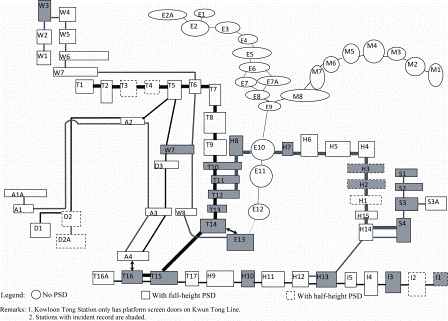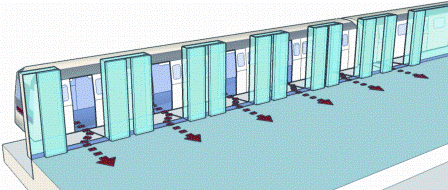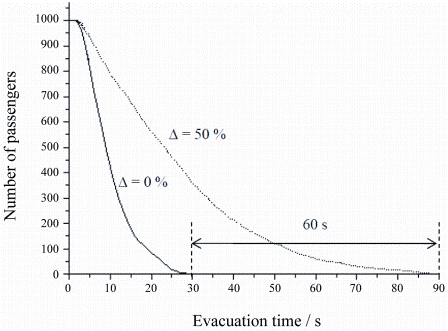Fire safety in subway stations with Platform Screen Doors
- Like
- Digg
- Del
- Tumblr
- VKontakte
- Buffer
- Love This
- Odnoklassniki
- Meneame
- Blogger
- Amazon
- Yahoo Mail
- Gmail
- AOL
- Newsvine
- HackerNews
- Evernote
- MySpace
- Mail.ru
- Viadeo
- Line
- Comments
- Yummly
- SMS
- Viber
- Telegram
- Subscribe
- Skype
- Facebook Messenger
- Kakao
- LiveJournal
- Yammer
- Edgar
- Fintel
- Mix
- Instapaper
- Copy Link
Posted: 31 August 2012 | W.K. Chow, Chair Professor of Architectural Science and Fire Engineering and Head of the Building Services Engineering Department, Hong Kong Polytechnic University | No comments yet
Platform Screen Doors (PSDs) can be found in many modern subway stations. However, 32 separate PSD incidents have been reported in Hong Kong since 2000, affecting approximately 3,000 passengers. Some of the incidents that occurred during this period included the glass panes of the PSDs suddenly breaking, and some trains not stopping in the right position at a station, causing the train doors to be out of line with the PSDs, resulting in passengers not being able to get off the train which meant it had to move onto the next station. If these incidents were to occur during a station fire, evacuation would be extremely difficult, especially on crowded stations, and the consequences could be very serious. How PSDs operate in a station evacuation scenario must be better understood to determine an appropriate fire safety management plan.
Very high passenger loading is seen every day during rush hours on the Hong Kong local subway system (see Figure 1 on page 92) and many incidents connected to fire and poor ventilation provision due to train suspension have been reported1, with over 70,000 passengers being affected since 1979. Some incidents were recorded in crowded train cars due to service suspension resulting from electrical signal faults and other unknown reasons. Ventilation provision in crowded train compartments was observed to be inadequate when the train stopped, leading to serious consequences1. No data on in-train air quality and subway stations under crowded conditions was released to the public2. The ventilation rate required should be adequate, as was stated years ago3.
Platform Screen Doors (PSDs) can be found in many modern subway stations. However, 32 separate PSD incidents have been reported in Hong Kong since 2000, affecting approximately 3,000 passengers. Some of the incidents that occurred during this period included the glass panes of the PSDs suddenly breaking, and some trains not stopping in the right position at a station, causing the train doors to be out of line with the PSDs, resulting in passengers not being able to get off the train which meant it had to move onto the next station. If these incidents were to occur during a station fire, evacuation would be extremely difficult, especially on crowded stations, and the consequences could be very serious. How PSDs operate in a station evacuation scenario must be better understood to determine an appropriate fire safety management plan. Very high passenger loading is seen every day during rush hours on the Hong Kong local subway system (see Figure 1 on page 92) and many incidents connected to fire and poor ventilation provision due to train suspension have been reported1, with over 70,000 passengers being affected since 1979. Some incidents were recorded in crowded train cars due to service suspension resulting from electrical signal faults and other unknown reasons. Ventilation provision in crowded train compartments was observed to be inadequate when the train stopped, leading to serious consequences1. No data on in-train air quality and subway stations under crowded conditions was released to the public2. The ventilation rate required should be adequate, as was stated years ago3.
Platform Screen Doors (PSDs) can be found in many modern subway stations. However, 32 separate PSD incidents have been reported in Hong Kong since 2000, affecting approximately 3,000 passengers. Some of the incidents that occurred during this period included the glass panes of the PSDs suddenly breaking, and some trains not stopping in the right position at a station, causing the train doors to be out of line with the PSDs, resulting in passengers not being able to get off the train which meant it had to move onto the next station. If these incidents were to occur during a station fire, evacuation would be extremely difficult, especially on crowded stations, and the consequences could be very serious. How PSDs operate in a station evacuation scenario must be better understood to determine an appropriate fire safety management plan.
Very high passenger loading is seen every day during rush hours on the Hong Kong local subway system (see Figure 1 on page 92) and many incidents connected to fire and poor ventilation provision due to train suspension have been reported1, with over 70,000 passengers being affected since 1979. Some incidents were recorded in crowded train cars due to service suspension resulting from electrical signal faults and other unknown reasons. Ventilation provision in crowded train compartments was observed to be inadequate when the train stopped, leading to serious consequences1. No data on in-train air quality and subway stations under crowded conditions was released to the public2. The ventilation rate required should be adequate, as was stated years ago3.
Fires in subway systems occur due to many reasons and numerous incidents in the past 30 years have been summarised1. It was fortunate that no casualties or serious fire disasters similar to that of the 2003 Daegu subway train fire4 occurred. Most of the fire incidents were small fires or smoke caused by a power fault or human error or negligence. Even the arson fire of 20045, which was bigger than the Daegu subway train fire4, did not lead to disaster. However, the amount of luggage carried by passengers6,7 appears to be on the increase, and fire hazards associated with passengers carrying lots of luggage must be reviewed.
Platform Screen Doors
PSDs are installed in transport networks of many other large cities in the Far East. Two types of PSDs are commonly found; half-height and fullheight. One of the advantages of installing half-height PSDs is to prevent passengers from falling onto the railway track. Full-height PSDs8,9 have many advantages including minimising the energy use of the station air-conditioning system; preventing passengers or objects from falling onto the track; preventing unauthorised access to the track; reducing the risk of accidents; reducing platform air velocities caused by train piston effect; and reducing noise, dust and gas pollution from the tunnel.
Table 1: Summary of PSDs incidents reported in news since 2000
|
Year |
Incident date |
Time of incident |
Time incurred |
Station |
Cause |
Number of passengers affected directly |
|
2002 |
21 August |
09:25 |
30 min |
Yau Ma Tei |
Screen doors failed to operate |
Unknown |
|
29 September |
14:00 |
— |
Po Lam |
Door gap clamped 4 year-old boy’s finger |
1 |
|
|
11 November |
16:00 |
— |
Tiu Keng Leng |
Door gap clamped 9 year-old girl’s finger |
1 |
|
|
2003 |
20 September |
17:10 |
20 min |
Prince Edward |
Screen doors failed to operate |
Unknown |
|
2004 |
4 September |
17:00 |
— |
Mong Kok |
Screen doors clamped a lady |
1 |
|
7 September |
14:11 |
30 min |
Jordan |
Screen door broken and hurt a lady |
1 |
|
|
20 October |
09:22 |
1 min |
Central |
Screen doors failed to open |
2000 |
|
|
2005 |
29 June |
— |
— |
Admiralty |
Screen doors failed to open |
About 200 |
|
6 July |
18:15 |
— |
Hang Hau |
Screen doors failed to open and passengers had to alight at the next station |
About 50 |
|
|
2006 |
3 February |
16:50 |
— |
East Tsim Sha Tsui |
Train moved while screen doors still opened |
Unknown |
|
23 March |
06:13 |
— |
Quarry Bay |
Screen doors failed to open |
Unknown |
|
|
October 2006 |
— |
— |
Yau Ma Tei |
Screen door broken |
Unknown |
|
|
November 2006 |
— |
— |
Tseung Kwan O |
Screen door broken |
Unknown |
|
|
2007 |
12 January |
13:00 |
— |
Shek Kip Mei |
Screen door broken |
Unknown |
|
28 July |
14:30 |
— |
Mong Kok |
Screen doors clamped a baby trolley and hurt the baby |
1 |
|
|
7 December |
09:06 |
— |
Admiralty |
Screen doors failed to open |
Over 600 |
|
|
11 December |
afternoon |
— |
Prince Edward |
Screen doors clamped a man with mobility impairment |
1 |
|
|
2008 |
21 April |
17:30 |
— |
Tiu Keng Leng |
Screen door broken |
Unknown |
|
2009 |
19 March |
18:00 |
— |
Lok Fu |
Screen doors clamped two women |
1 |
|
24 August |
evening |
— |
East Tsim Sha Tsui |
Train moved while screen doors still opened |
Unknown |
|
|
23 December |
20:00 |
— |
Hang Hau |
Screen doors failed to open and passengers had to alight at the next station |
About 100 |
|
|
2010 |
27 January |
18:05 |
— |
Shau Kei Wan |
Screen door broken |
Unknown |
|
1 May |
23:30 |
— |
Tsim Sha Tsui |
Screen door broken |
Unknown |
|
|
2011 |
15 May |
18:55 |
4 min |
Kowloon Bay |
Screen doors failed to open |
About 10 |
|
17 June |
09:40 |
— |
Tin Shui Wai |
Screen doors failed to open |
Unknown |
|
|
2 August |
08:24 |
2 hours |
Kowloon Bay |
Screen doors failed to open |
Unknown |
|
|
7 September |
17:00 |
— |
Ngau Tau Kok |
Screen doors failed to open |
Unknown |
|
|
21 September |
— |
— |
Ngau Tau Kok |
Screen doors failed to open |
Unknown |
|
|
22 September |
06:00 |
8 hours |
Kowloon Bay |
Screen doors non-smooth operation |
Unknown |
|
|
2012 |
11 April |
06:30 |
3 hours |
Chai Wan |
Screen doors failed to open |
Unknown |
|
3 May |
08:40 |
— |
Nam Cheong |
Screen door broken |
Unknown |
|
|
4 May |
17:50 |
5 min |
Prince Edward |
Screen doors failed to open |
Unknown |
In a recent review10, 32 separate PSD incidents occurred in subway stations in Hong Kong since 2000. As shown in Table 1, approximately 3,000 passengers were affected and a layout of the station in question is shown in Figure 2 opposite.


Figure 2: Subway system in Hong Kong
The gap between the PSD and train wall used to be very narrow. There are great concerns on the safety aspects of PSDs, particularly in an emergency evacuation. Passengers on platforms with PSDs and a ventilation system might take a long time to evacuate. The time delay can be up to 350s11 more than in the evacuation on platforms without PSDs.
Most PSD research has focused on the indoor environment and energy use of the platform air-conditioning system12-14; and safety management to prevent railway suicides with altering human perception15. Very few studies have reported on the associated operational problems on fire evacuation as reviewed recently. The problem of fire evacuation can be very serious if the train doors do not open at the right position, as has happened many times in Hong Kong10. The effect of PSDs on emergency fire evacuation was recently reported in detail9.
Fire evacuation in stations with PSDs
Sometimes, train doors and PSDs do not match when the train stops at the station (see Figure 4a).


Figure 4a: Train stopped at wrong position – not lined up wtih PSDs
Fire evacuation of passengers in a crowded platform with PSDs was recently studied. Evacuation times under different passenger loadings from a train vehicle were estimated with several operating conditions of PSD. The scenario with a fire in a platform was studied by the Computational Fluid Dynamics (CFD) tool Fire Dynamics Simulator (FDS) version 5.416.
As reported, passengers can evacuate directly when the trains stop in normal conditions where Δ is 0%. But when Δ was reduced to 30%, passengers in some train cars would attempt to move away from the fire first. They then evacuated from the adjacent train cars. The case with 1,000 passengers evacuating from those train cars with Δ up to 50% was studied. The simulated extended evacuation time due to reduced door width for Δ of 50% is shown in Figure 5. It is clear that the time for evacuating 1,000 passengers would be extended by 60s, taking 90s instead of 30s, extended by 200%.


Figure 5: Extension of evacuation time due to reduction in exit width
Train evacuation will become more difficult during the morning and evening peak hours when the passenger density in train cars is higher than 3.5 persons/m2. Appropriate fire safety management has to be implemented on such heavy loading. In the case of a train stopping at the wrong position to give Δ of 50%, the time for evacuating 1,000 passengers will be extended by 200%. The situation is very dangerous for underground subway stations.
Timeline analysis
Another problem identified in subway system evacuation is applying the timeline approach17 in Performance-Based Design (PBD). The Available Safe Egress Time (ASET) was simulated by fire models by referring only to reported data on tenability criteria on thermal exposure and smoke. The Required Safe Egress Time (RSET) was estimated with evacuation software. ASET and RSET are then compared with the safety margin (ASET – RSET) evaluated.
However, serious concerns for crowded and big subway station halls were pointed out recently18,19, including:
- Scenarios with small design fires were used to get long ASET
- ASET used to be estimated without taking into account smoke toxicity of chemical species, only carbon monoxide was included. ASET can be much shorter
- Human behaviour under local conditions was not investigated in depth to obtain good estimation of RSET. Consequently, the timeline approach was criticised to be a flawed concept assuming robotic motion20,21
- RSET was simulated by evacuation model without including human behaviour of local citizens, the actual RSET might be very long
- Short RSET estimated by assuming low passenger loading
- The safety margin (ASET – RSET) is only taken as a percentage of RSET, not several times of RSET.
Large public transport stations in dense cities used to be built underground with several levels. Emergency evacuation from the lowest platform level would cover a very long travel distance. Delays during train evacuation might lead to serious consequences and chaotic situations. Emergency evacuation in peak hours should not only refer to the train and station evacuation; the scenarios of crowded platforms should also be considered. If the train does not stop at the right position, the emergency evacuation time will be prolonged. Results show that a little reduction of exit width can lead to a longer evacuation time. Evacuation management will be made more difficult. Passengers in crowded stations may jam up at the exits.
Fire suppression systems in subway station platforms
Many passengers, known as ‘parallel traders’6, carry a lot of luggage when they board a train, particularly seen at stations close to the Chinese border. It was reported that burning a road truck with such heavy fire load would give a peak heat release rate of 200 MW23. In-depth studies in Korea and Japan23 indicated that burning an empty train car can result in a peak heat release rate as high as 20 MW. Even rough estimation gave 17 MW for burning an empty train car in the local railway line24. Therefore, burning a train car with luggage might give a peak heat release higher than 50 MW, unless full-scale burning data on local combustible products indicated a lower value.
There were no explanations to the general public about the measures which are deployed to suppress big fires in the station platform. It is not clear how a big fire resulted from burning a train car packed with luggage, if occurred in those subway station platforms, can be controlled by the subway system management. Therefore, the daunting task of fighting big fires, presumably, would be left to firemen. Note that several fire-fighters have been killed in big disastrous fires in buildings without sprinklers operating properly. Over 70,000 passengers have been affected by fire and ventilation provision in the past 30 years1. An arson fire broke out5 in 2004, fortunately it did not lead to disaster. The chance of having a fire is not low, therefore hidden fire safety problems should be watched.
The two railway corporations in Hong Kong, with most of the shares held by the government, merged in 2007. At that time, over 50 station platforms were not equipped with sprinklers25. Concerns were raised immediately by the public after the merger five years ago. Sprinkler systems are effective in controlling the scale of fire26 and avoiding big disasters by:
- Direct action on the burning objects
- Cooling the smoke layer to lower the chance of flashover
- Pre-wetting the adjacent combustibles to delay ignition
- Displacing oxygen from the burning objects Fire safety provisions in subway station platforms should be reviewed carefully with support from in-depth research.
Conclusion
Passenger flows in peak hours of the local subway system were observed to be very high, reaching 70,000 passengers per hour along one travel direction2. In view of the high passenger loading during peak hours and the long travel distance in some underground subway stations, a workable emergency evacuation management scheme must be determined. However, in-depth research studies of this topic were not yet found. Although research on fire science and engineering related to subway stations were only conducted in advanced countries, such works are not yet justified to be applicable in the Far East. That is because very few advanced countries have huge volumes27 of passengers, nor ‘parallel traders’. In case of failing to provide a fire suppression system in subway station platforms, the real fire would not be as small as the assumed design fire below 5 MW in overseas advanced countries. Note that even advanced countries are starting to study heat release rate in burning train cars with luggage recently.
PSDs are commonly installed in train stations to provide a more comfortable environment. However, evacuation simulation on subway stations with PSDs under fire should be watched as pointed out recently9. Emergency evacuation should be watched in underground railway stations. Carrying out a few demonstration tests24 and simulation of emergency evacuation with robotic motions20,21 are not sufficient. Installation of sprinkler system might not be adequate, though the fire statistics indicated that the system was effective in controlling big fires. Appropriate fire suppression systems29,30 should be set up accordingly. It should be noted that water mist systems had been installed in train cars and areas adjacent to PSDs in some subway stations in China30. The effectiveness of such systems should be further examined by systematic research. In conclusion, fire safety in crowded subway stations should be reviewed carefully.
References
1. W.K. Chow, L. Qu and Edgar C.L. Pang, “Incidents on fire and ventilation provision in subway systems in Hong Kong”, International Journal of Engineering Performance- Based Fire Codes, Vol. 10, No. 3, p. 41-47 (2011).
2. Hong Kong MTR homepage (2009). http://www.mtr.com.hk
3. W.K. Chow, “Ventilation of enclosed train compartments in Hong Kong”, Applied Energy, Vol. 71, pp. 161-170 (2002).
4. South China Morning Post, “Taegu’s subway line has been beset by disaster”, Main Section, p. 10, Hong Kong, 19 February (2003).
5. South China Morning Post, “14 injured in peak-hour MTR arson attack”, Editorial, p. A1, Hong Kong, 6 January (2004).
6. The Sun, “Parallel traders caught at Sheung Shui Station”, Hong Kong, 16 December (2010) – In Chinese.
7. W.K. Chow, “Fire safety concerns for subway systems in Hong Kong”, Fire Safety Asia Conference (FiSAC) 2011, Suntec, Singapore, 12-14 October (2011).
8. L. Qu and W.K. Chow, “Fire safety for public transport interchanges in Hong Kong”, Proceedings of the First International Conference on Building Energy and Environment, Tianjin University, Dalian University Intelligent Transport Volume of Technology, 13-16 July 2008, Dalian, China, p. 2255-2262 (2008).
9. L. Qu and W.K. Chow, “Platform screen doors on emergency evacuation in underground railway stations”, Tunnelling and Underground Space Technology, Vol. 30, p. 1-9 (2012).
10. W.K. Chow and Edgar C.L. Pang, “Survey on incidents with PSD in Hong Kong”, Department of Building Services Engineering, The Hong Kong Polytechnic University, June (2012). Available at: http://www.bse.polyu.edu.hk/researchCentre/Fire_Engi neering/Hot_Issues.html
11. J.S. Roh, H.S. Ryou, W.H. Park and Y.J. Jang “CFD simulation and assessment of life safety in a subway train fire”, Tunnelling and Underground Space Technology, Vol. 24, No. 4, p. 447-453 (2009).
12. S.C. Hu and J.H. Lee, “Influence of platform screen doors on energy consumption of the environment control system of a mass rapid transit system: case study of the Taipei MRT system”, Energy Conversion and Management, Vol. 45, No. 5, p. 639-650 (2004).
13. J.Y. Kim and K.Y. Kim, “Experimental and numerical analyses of train-induced unsteady tunnel flow in subway” Tunnelling and Underground Space Technology, Vol. 22, p. 166-172 (2007).
14. C.J. Lin, Y.K. Chuah and C.W. Liu, “A study on underground tunnel ventilation for piston effects influenced by draught relief shaft in subway system”, Applied Thermal Engineering, Vol. 28, p. 372-379 (2008).
15. C.K. Law, Paul S.F. Yip, Wincy S.C. Chan, King-Wa Fu, Paul W.C. Wong and Y.W. Law, “Evaluating the effectiveness of barrier installation for preventing railway suicides in Hong Kong”, Journal of Affective Disorders, Vol. 114, No. 1-3, p. 254-262 (2009).
16. T. Korhonen and S. Hostikka, Fire Dynamics Simulator with Evacuation: FDS+Evac Technical Reference and User’s Guide, FDS 5.4.0, Evac 2.2.0 (2009).
17. CIBSE Guide E: Fire Engineering, The Chartered Institution of Building Services Engineers, London, UK (2010).
18. W.K. Chow, “Six points to note in applying timeline analysis in performance-based design for fire safety provisions in the Far East”, International Journal on Engineering Performance-Based Fire Codes, Vol. 10, No. 1, pp. 1-5 (2011).
19. W.K. Chow, “Timeline analysis with ASET and RSET”, Department of Building Services Engineering, The Hong Kong Polytechnic University, September (2011). Available at: http://www.bse.polyu.edu.hk/research Centre/Fire_Engineering/Hot_Issues/ARTL1.pdf
20. V. Babrauskas, J.M. Fleming and B.D. Russell, “RSET/ASET, a flawed concept for fire safety assessment”, Fire and Materials, Vol. 34, pp. 341-355 (2010).
21. W.K. Chow, “Comment on ‘RSET/ASET, a flawed concept for fire safety assessment’ by V. Babrauskas, J.M. Fleming and B.D. Russell, Fire and Materials, Vol. 34, pp. 341-355 (2010)”, Letter to the Editor, Fire and Materials – Accepted to publish, March (2012).
22. W.K. Chow “Several points to note in performancebased design for fire safety provisions in Hong Kong” The National Symposium on Fire Safety Science and Engineering, 14-16 October 2010, Beijing, China (2010).
23. Proceedings of 2011 Exchange Meeting for SFPE Asia- Oceania Chapters – Transportation Fire Safety, Korea Railroad Research Institute & SFPE Korean Chapter, Seoul, Korea, 28 April (2011).
24. M.C. Luo and K. Wong, “Ma On Shan Rail system-wide fire safety strategy: approach and justification”, Consultancy Report, The Arup Journal, Vol. 3, p. 40-42 (2007). http://www.arup.com/_assets/_download/7D52C0BB- 19BB-316E-40B5AE8D249C932B.pd
25. Oriental Daily News, “No sprinkler system at 53 MTR platforms”, p. A22, Hong Kong, 10 April (2007) – in Chinese.
26. W.K. Chow and N.K. Fong, “Application of field modelling technique to simulate interaction of sprinkler and fireinduced smoke layer”, Combustion Science and Technology, Vol. 89, p. 101-151 (1993).
27. C.S. Jiang, F. Li, W.K. Chow and X.L. Wang, “Lessons learnt from crowding at two railway stations in China during the spring festival”, The 9th IIASA-DPRI FORUM on Integrated Disaster Risk Management, 12-16 October 2009, Kyoto, Japan (2009).
28. A. Lönnermark, J. Lindström and Y.Z. Li, “Baggage and ventilation play an important part in the spread of fire in railway carriages”, Brandposten #44, p. 24 (2011).
29. W.K. Chow, “Updating fire safety for subway systems in Hong Kong”, 1st International Workshop/Symposium on Mass Transit Rail Facilities Design and Management (1st ISMTRFDM 2011), 4-5 August 2011, Suzhou, China (2011).
30. Proceedings of the 1st International Workshop/ Symposium on Mass Transit Rail Facilities Design and Management (1st ISMTRFDM 2011), 4-5 August 2011, Suzhou, China (2011).
About the author
Professor W.K. Chow is the Chair Professor of Architectural Science and Fire Engineering at The Hong Kong Polytechnic University. He has also been the Head of the Department of Building Services Engineering since 2009. Professor Chow started his teaching career at Hong Kong Polytechnic as an Assistant Lecturer in 1981, promoted to Chair Professor in 1998. He also leads the Research Centre for Fire Engineering at the University, and the former Area of Strength: Fire Safety Engineering.








